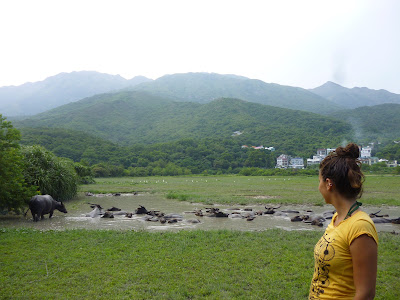Como no podía ser de otra manera, no hemos podido evitar el
llevar menos ropa limpia y más libros en la mochila. Luego dirán que el saber
no ocupa lugar…
Aquí os contamos un poquito sobre nuestros compañeros de
viaje.
Demons, Fyodor
Dostoievsky. Aunque Álvaro es docto en la literatura rusa, ésta era una de mis asignaturas pendientes. Empezar con
un libro en inglés de setecientas páginas no ha sido tan malo como suena. En
palabras de hoy en día, se trata de un excelente culebrón de la Rusia de la
segunda mitad del siglo XIX. Lo que más me ha gustado ha sido la caracterización
de los personajes y el trasfondo revolucionario. Lo que menos me ha gustado ha
sido la falta de relaciones de verdadera amistad entre lxs protagonistas.
Le père de nos pères, Bernard Werber. Después de su obra
maestra, la trilogía de Les Fourmis,
no pudimos evitar hacernos con este libro. Especialista en narrar historias
paralelas que al final están siempre conectadas, Werber maneja muy bien el
suspense. Lo que más nos ha gustado como cuenta una historia desde el punto de
vista de un animal, así como las diferentes teorías de la evolución. Lo que
menos le ha gustado a Álvaro (yo soy una fanática de este escritor) ha sido la poca verosimilitud de una de los
dos hilos argumentales.
To kill a mockingbird, Harper Lee. Este clásico de
los sesenta, del que se hizo una película que estamos deseando ver, es una obra
maestra. Es un cuadro de la sociedad sureña (la historia es narrada por una
niña de Alabama) del periodo de entreguerras, con la problemática del racismo
como trasfondo. Brillante. Tenéis que leerlo.
The White Castle, Orhan Pamuk. No quería darme por vencida
después del chasco de Estambul, ciudad y
recuerdos. Parece que ha sido una buena idea darle una segunda oportunidad
al premio Nobel turco. Su primera novela, un librito, narra la vida de un
esclavo italiano en Estambul que desarrolla una relación muy particular con su
amo. Hace una reflexión interesante sobre el yo y el otro, que sin embargo no
termina de completar. Es una pena.
Burmese days,
George Orwell. Como el origen de este
largo viaje está en mis ganas de ir a Birmania, el libro de Orwell no podía faltar
en la mochila. Se trata de un magnifico retrato de la época y la mentalidad
coloniales. Lo que no le ha gustado a Álvaro ha
sido que la historia es un poco floja. Sin embargo, es muy útil para
hacerse una idea de lo que fue Birmania en el periodo de entreguerras.
Porque leer también es viajar, ¡no dejéis de leer en casa!


















































